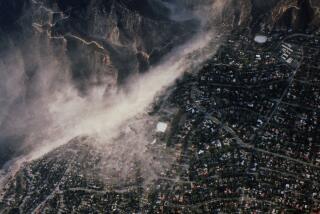‘Rough-Hewn Land’ by Keith Heyer Meldahl: Book review
Rough-Hewn Land
A Geologic Journey From California to the Rocky Mountains
Keith Heyer Meldahl
University of California Press: 297 pp., $34.95
Think of the West and what comes to mind are vertiginous peaks, sculpted tablelands and the infinite vistas of basin and range country. In other words, geology.
Westerners live in the shadow of mountains that are still rising, on the edge of a continent on the move, over fault systems that can unleash the power of nuclear bombs. More so than any other region of the country, we are defined by geology.
In “Rough-Hewn Land,” Keith Heyer Meldahl takes us on a field trip from San Francisco to the Rocky Mountains, tracing the genealogy of the landscape. He seasons the story with historical accounts and a synthesis of evolving geologic theory, providing a fascinating guide to the formation of the West.
“Geology,” Meldahl writes, “is stranger than fiction.” How did material that was once buried miles beneath the Pacific seabed in the deep ocean wind up a rock in the Sierra Nevada with a pine tree poking out of it? How did the Rockies, far from the classic mountain-building forces of the continental edge, get tall enough to leave hikers gasping for oxygen?
The answers lie in the ancient forces of plate tectonics, volcanism and upheaval that birthed the West and continue to shape it. If there is an overarching theme of the book, it is that the region remains geologically alive.
The Pacific Plate, which includes coastal Southern California, is creeping to the Northwest at a rate of about 2 inches a year. The Great Basin is stretching, annually adding a half-inch to the distance between Reno and Salt Lake City. In 1872, the Sierra Nevada in an instant lurched 6 feet when one of the most violent earthquakes in California’s recorded history jolted the Owens Valley, nearly leveling Lone Pine and killing more than two dozen residents.
Fittingly for a state full of immigrants, it turns out that, geologically speaking, California isn’t native either. “Wherever you stand in this state, if your feet are on bedrock, the odds are that you’re standing on an immigrant, reeled in by subduction from the far reaches of the Pacific in the process of assembling California,” writes Meldahl, a geology professor at MiraCosta College in San Diego County.
As the Pacific floor spread, fed by lava welling up from midocean ridges, it collided with the westward-creeping North American plate and plunged under it. During the last 200 million years, ancient seabed was scraped off and left behind, attaching itself to the continent’s edge and incrementally building the Golden State.
As Californians know all too well, earthquake faults mark plate boundaries. But Meldahl, who cites an extensive bibliography, says the common perception that the San Andreas fault marks the edge of the North American Plate is wrong. Rather, he argues that there are a series of fault systems, including those in eastern California, that are breaking up the continent’s southwestern corner. “The message is clear — the western 500 miles of the southwestern United States are slowly tearing away from the rest of the continent.”
The good news: In 15 million more years or so, there will be more ocean-front real estate: “Every likely projection points to one conclusion: continental fragmentation and eventual beachfront property in the deserts of the American West.”
But all those L.A. haters waiting for the Southland to sink into the Pacific are going to be disappointed. Even when it splits from the mainland, coastal California will be too buoyant to disappear into the Earth’s mantle.
Meldahl has a sense of humor. In one photo, he uses crumpled beer cans to illustrate his point. He also intertwines history with geology, explaining the origins of the gold that launched California’s Gold Rush (Hint: It came from somewhere else) and Nevada’s mineral wealth. Settlers crossing the Sierra had to dismantle their wagons and hoist them up the eastern face of the range because glaciers had chiseled it into a daunting obstacle.
He quotes 19th century explorer and geologist John Wesley Powell’s puzzlement over rivers in the Northern Rockies that cut through ridges they could have easily flowed around. Powell didn’t have the right answer: He thought the rivers preceded the mountains.
The mountains are in fact much older. In what geologists call “The Exhumation,” the rivers — aided by uplift and ancient climate change — washed away the sand and gravel that had all but buried the Rockies.
For those who want to see for themselves, Meldahl has included an appendix with latitude-longitude coordinates to find key sites he mentions in the book.
Informative and highly readable, “Rough-Hewn Land” belongs on the shelf of any Westerner curious about how that stunning view through the windshield came to be.
bettina.boxall@latimes
More to Read
The biggest entertainment stories
Get our big stories about Hollywood, film, television, music, arts, culture and more right in your inbox as soon as they publish.
You may occasionally receive promotional content from the Los Angeles Times.











